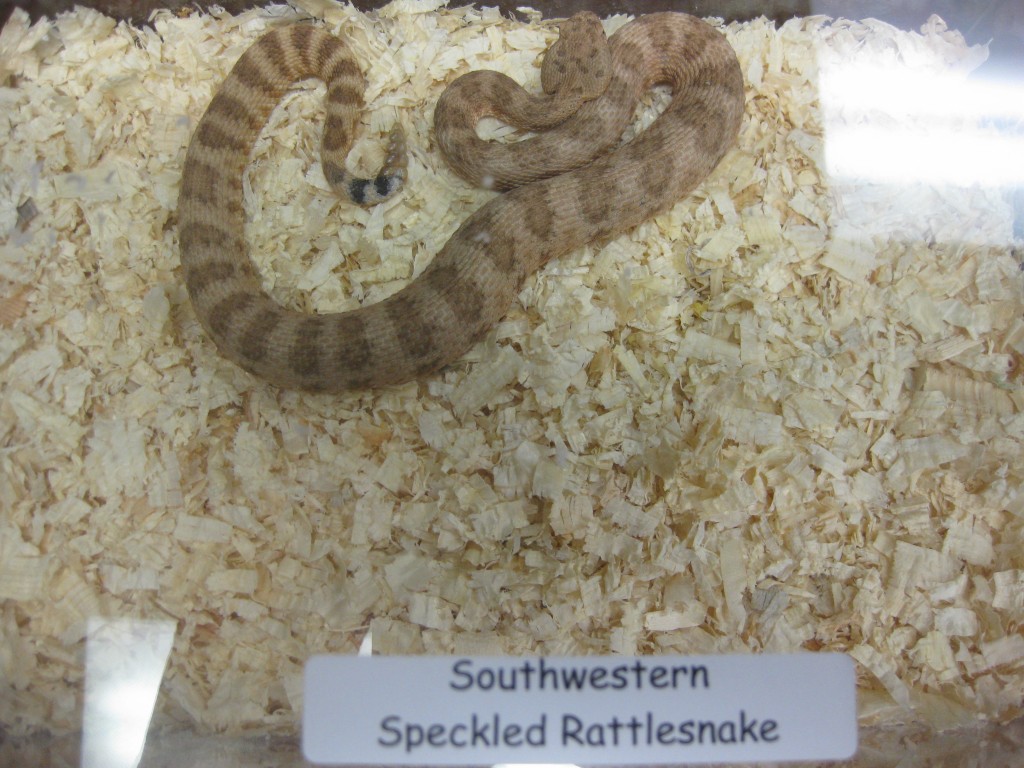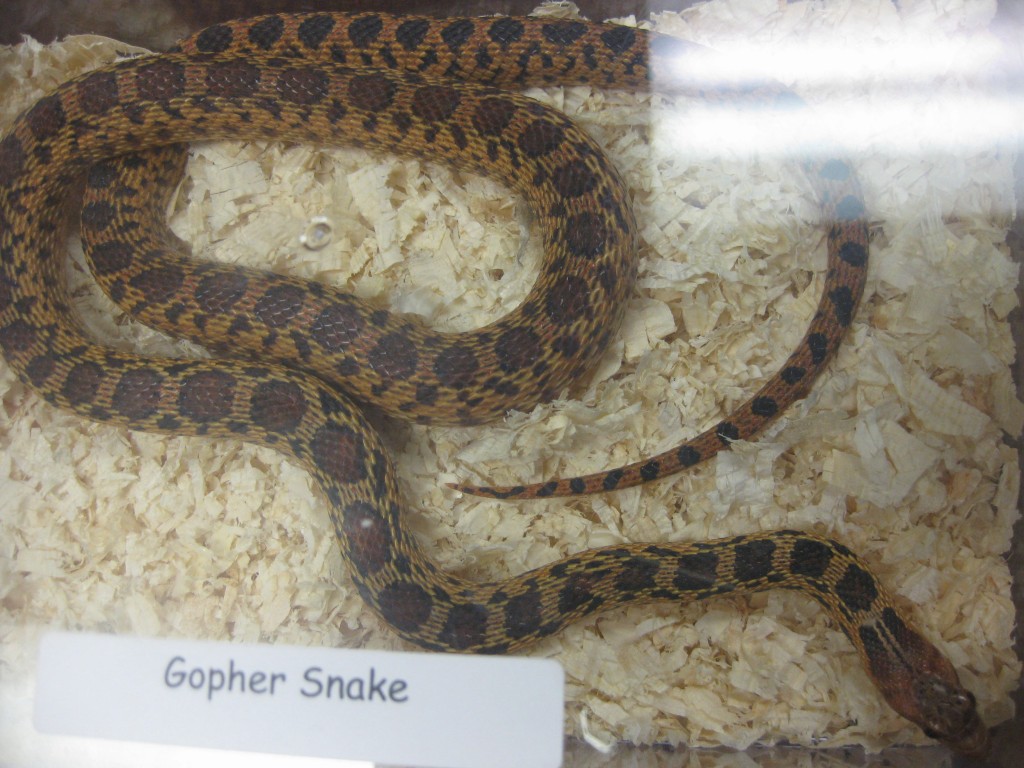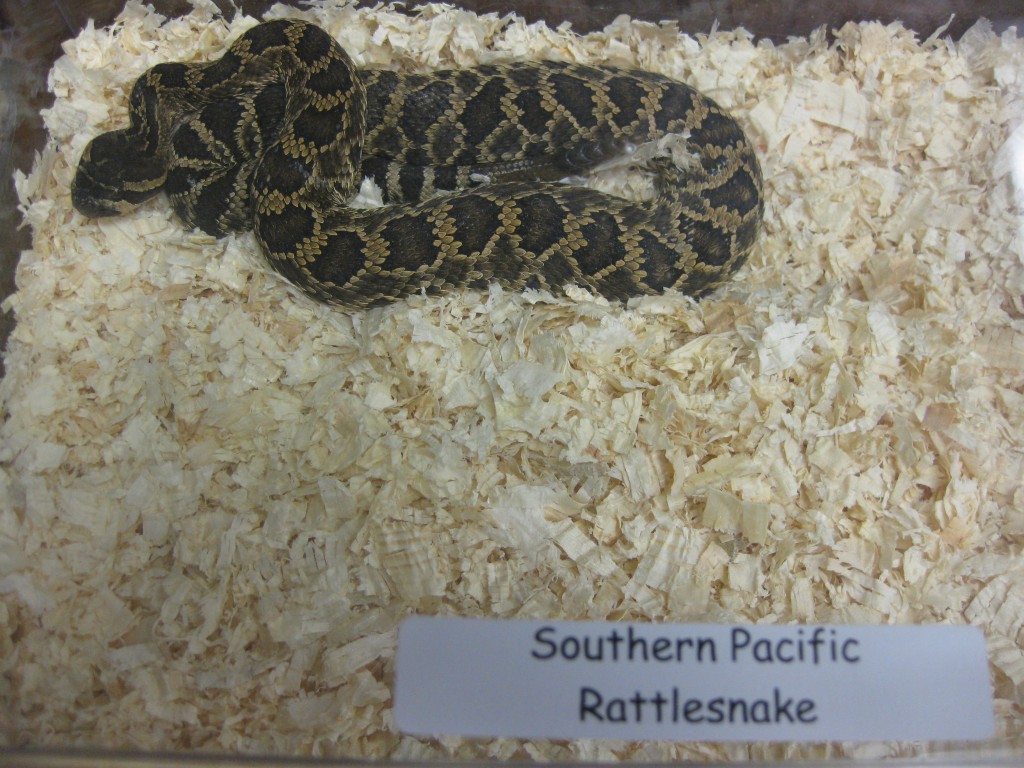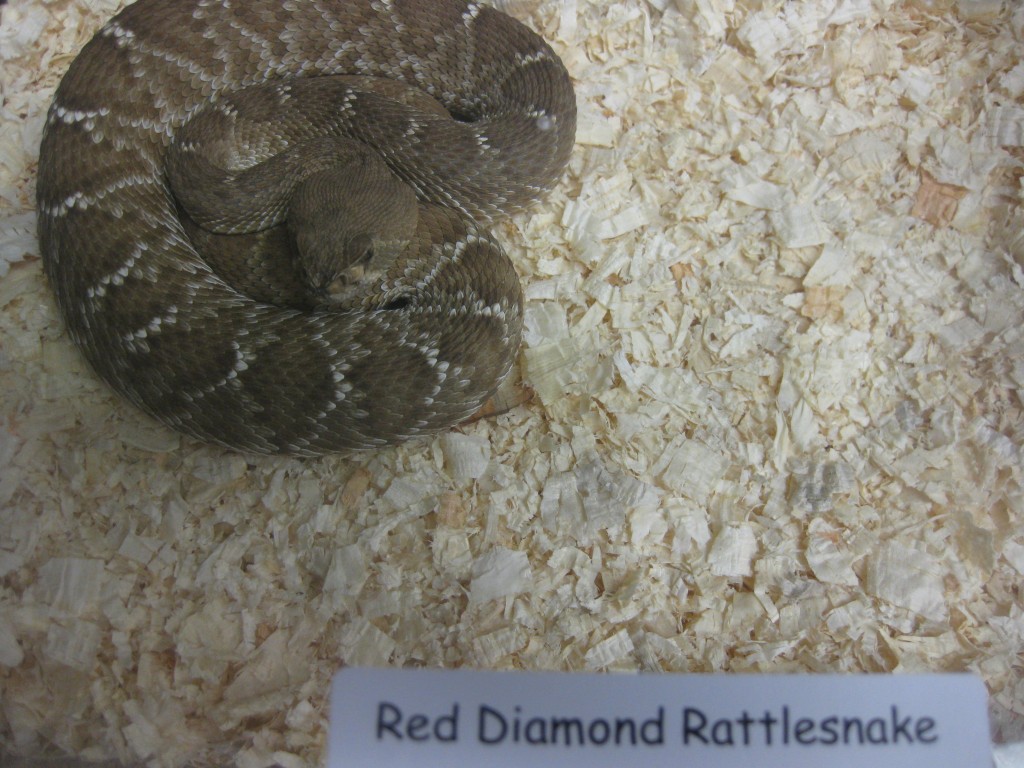Just back from a pleasant mom’s night out.
I went to a rattlesnake talk at The Reserve at Ranch Mission Viejo in San Juan Capistrano.

This Southwestern Speckled Rattlesnake clearly shows two of the three telltale signs of a dangerous pit viper: a rattle and a wedge-shaped head.
Steve Bledsoe (and Noah Anderson), two avocational herpetologists, gave an excellent presentation tonight. I got permission from Steve to share a version here. I am including my weak photographs for quick reference to the three kinds of rattlers found in Orange County plus a comparison shot with a Gopher Snake. There are much better photographs at the Southwestern Field Herping Associates website, www.swfieldherp.com, and at www.californiaherps.com.
I came in a bit late (Noah assured me that I only missed a few bad jokes…), right as Steve was explaining the three main ways of identifying a rattler versus a harmless snake.
A rattler has
1) a rattle at the end of the its tail. Obvious, but keep in mind that baby rattlers might only have a “button” and sometimes rattles fall off through accident or injury.
2) retractable fangs. These bad boys have hollow fangs that fold back into the top of their mouth when not in use.
3) an obvious large triangular head due to the venom glands. A harmless snake has a narrow head that is often an indistinguishable extension of the slender body. The head can also be described as heart-shaped, diamond-shaped, or spade-shaped (nearly all the suits).
Furthermore, rattlesnakes have thick heavy bodies in comparison to harmless snakes. (Steve showed excellent pictures to illustrate all these things. I highly recommend catching his powerpoint presentation if you can.)
Rattlesnakes have cat eyes or elliptical pupils (which make them look extra scary – like Voldemort ). A harmless snake like a gopher has round pupils (friendly!)
All the venomous snakes in OC are pit vipers. And so, they have two pits (read: holes) in the front of their face which are highly specialized heat sensors. In fact, pit vipers see the world in terms of heat, just like another movie bad guy, the Predator.
Rattlers use their forked tongue to aggressively look fearsome by letting it hang out for several seconds and then flipping it up and repeating this action over and over. A harmless snake uses its tongue for “smelling” only and flicks it quickly in and out.
Keep in mind that snakes are deaf and will be terrified of you long before you appear on the trail. Snakes feel the vibrations of your tramping heavy footsteps and will resort to their best choice defense mechanism – staying stock still or “hiding in plain sight.” If freezing doesn’t work, then they will try to slither away. If threatened, a rattlesnake will rattle and hiss. This is a last attempt to scare you away.
What should you do if you see a rattlesnake? BACK AWAY SLOWLY. Under no circumstances will a snake come after you.
What should you do it you hear a snake but don’t see it? FREEZE and find the snake visually so that you do not inadvertently walk towards the snake.
What should you do if you get bit? RELAX AND CALL 911. No seriously, relax. The best thing to keep your heart from pumping and spreading venom throughout your body is to breathe slowly and deeply and relax (think about Crouching Tiger, Hidden Dragon and how he meditated to stop the poison from flowing).
DO NOT cut and suck, apply tourniquets, or drink alcohol or caffeine.
DO wrap the affected limb in an ace bandage to slow swelling, use a splint to restrict movement, and apply a cold washcloth to the forehead because nausea is common.
Your best shot is getting to a hospital ASAP so you can get a dose of anti-venom, which here in OC is a broad spectrum, poly-valent anti-venom, called Crofab, and is used for all poisonous snake bites in OC.
Your best snake bite kit is your cell phone and a GPS. Know your lat-long (latitude-longitude) if you are in the back country.
Some snake bite facts to keep in mind:
35% of all poisonous snake bites are DRY. That means that NO VENOM is injected.
Bites from large rattlesnakes are MORE dangerous than bites from juveniles. It is a common misconception that rattlers control venom dosage – nor do baby rattlers strike repeatedly. Bigger snakes have more venom, They also have larger, longer fangs.
In 2009 there were 5,234 snake bites reported. Of these, only three were fatal. That is less than .1%. So, while a rattlesnake bite is serious, it is very unlikely you will die from it.

The common and useful Gopher Snake is often fatally mistaken for a rattlesnake. He actually pretends to be a rattler by flattening his head, coiling, and shaking his rattle-less tail. Note that his tail is thin and narrow. His pupils are round, and his head is still narrow.
Steve also leads snake walks at Casper’s Wilderness Park in the spring. I took Christian on one (see post here) but after Steve saw all the kids I had in tow (3-4 families showed up) he moved the age of the hikes up to a minimum of 8 years old. Heh, heh. I guess I push people to set boundaries.
Note: Steve highly recommends Jeffrey Lemm’s Field Guide to Amphibians and Reptiles of the San Diego Region. (Dang it – I still don’t have my affiliate program set up! And this a book I can wholehearted support buying.)
A BIG THANK YOU TO STEVE AND NOAH FOR ALL THEIR VOLUNTEER WORK IN THIS COMMUNITY!


